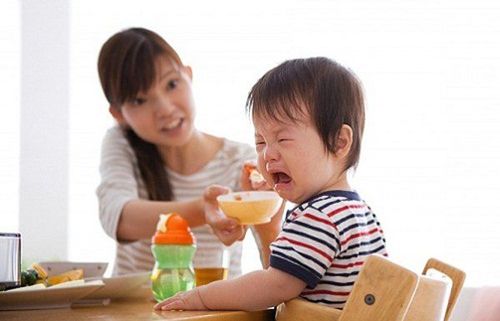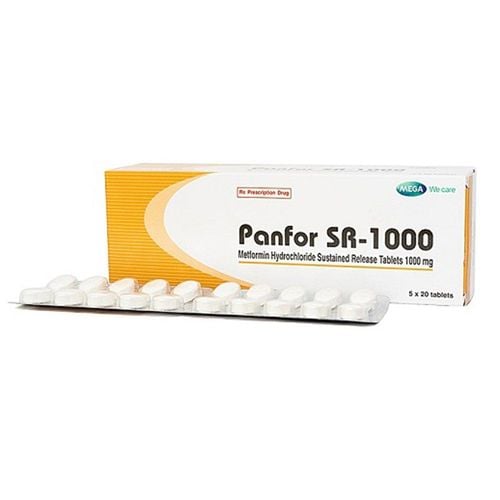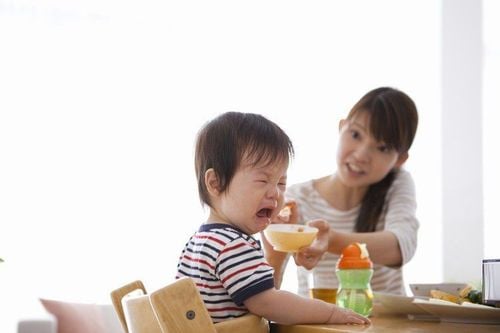This is an automatically translated article.
Children anorexia is a common condition and worries many parents. So what do anorexic children eat, how to build a menu for an anorexic child so that they can eat better while still ensuring nutrition.
1. What is an anorexic?
Anorexia is a condition where the child has no or little appetite, eats little and eats for a long time (each meal can last more than 30 minutes), the child only eats certain foods, or has may not eat, even fear the sight of food.
Children with anorexia for a long time can lead to malnutrition, mental retardation, rickets,...

Trẻ biếng ăn trong thời gian dài là nguy cơ dẫn đến còi xương và chậm phát triển
2. Why is the child anorexic?
There are many causes of anorexia in children, it can be due to:
Due to diet and nutrition: Giving children solid foods too early, forcing children to eat too much or eating close to each other, changing foods sudden, unbalanced diet, excess protein and fat, lack of fiber and micronutrients, poor food, unsuitable for children's taste, monotonous processing.
Psychological reasons: Psychological anorexia caused by children being bullied, yelled at, forced to eat or pampered during meals, for children to eat and play at the same time, parents and families do not or little care about meals of children, children have not yet adapted, are afraid to change the eating environment (time, place to eat,...). Due to pathology: Some acquired diseases can make children anorexic, such as digestive and oral diseases (dental caries, mouth ulcers, gastritis, enteritis,...), acute bacterial infections. and chronic (pneumonia, tuberculosis, helminths, .....) or the child is taking antibiotics for treatment.

Có nhiều nguyên nhân khiến cho trẻ cảm thấy chán ăn
3. Principles of building menus for anorexic children
Menus for children with anorexia need to be built based on the following principles:
Each meal must ensure 4 main food groups: flour (rice, tapioca, tapioca, corn), protein (meat types) such as pork, beef, chicken; seafood such as fish, shrimp and crab; eggs, milk and dairy products, cereals), fats (animal fats, vegetable oils such as peanuts, sesame) , fiber and vitamins (green vegetables, tubers, ripe fruits). The ratio of each food group in the diet is reasonable: In each meal, it is necessary to balance the ratio between the food groups, ensuring that the protein and fat groups are derived from both animals and plants.
Ensure children's energy needs: Children who are anorexic for a long time will be prone to malnutrition, growth retardation, and rickets, so meals need to ensure adequate supply of minimum energy requirements for 1 day. day for children. The energy requirement of children from 1-3 years old is 1200Kcal/day, children from 4-6 years old is 1500Kcal/day, children aged 7-9 is 1850Kcal/day and children from 10-12 years old is 2000-2100kcal/day . The menu needs to be diverse, not repetitive, constantly changing. Diversify foods from each group at each meal, but limit processed or packaged foods.

Nên đa dạng thực đơn và đảm bảo dinh dưỡng trong mỗi bữa ăn của trẻ
4. What to do when the child is anorexic?
To overcome anorexia in children, parents and caregivers should pay attention to the following points:Anorexic children often eat little or very little, so they should divide meals, let children eat many meals a day. . Meals should be spaced about 2-3 hours apart. Initially, children can eat less, then gradually increase the amount of protein and energy in the child's diet. Prioritize soft and easily digestible foods for young children. Avoid making food too salty, use iodized salt when processing. Food should be prepared according to the taste and age of the child. Give your child enough water to drink, including filtered water, or fruit juices, vegetables. Children should not eat snacks before each meal because it will make them anorexic due to full stomach and no appetite. Avoid distracting children during meals with electronic devices such as televisions, phone screens, toys,... Children with anorexia are the concerns and questions of many parents. To overcome children's anorexia, parents need to develop a suitable and varied menu for their children to stimulate their appetite, while ensuring adequate nutrients and energy for children.
If the child's anorexia persists for a long time, parents should supplement children with supportive products containing lysine, essential micro-minerals and vitamins such as zinc, chromium, selenium, and B vitamins to help fully meet their needs. nutritional requirements in children. At the same time, these essential vitamins also support digestion, enhance nutrient absorption, help improve anorexia, and help children eat well. Parents can also apply dietary supplements and functional foods derived from nature for easy absorption by the baby. The most important thing is that the improvement of the baby's symptoms must take place over the long term. Combining many types of functional foods at the same time or changing many types in a short time can make the baby's digestive system unable to adapt and completely not good. Therefore, parents must be really persistent with their children and regularly visit the website vimec.com to update useful baby care information.













